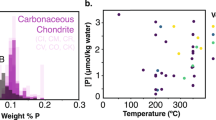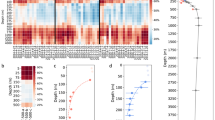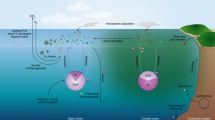Abstract
The elements C, N and P are mostly biologically recycled in the upper ocean. Consequently, nutrient cycling and food web dynamics are central problems in marine biology and chemistry. The natural stable isotopes 13C and 15N and the radioisotopes 3H, 14C and 32P have been used to estimate rates of in situ photosynthesis, nucleic acid synthesis1,2 and new production3–8, but previously there was no practical way of studying the gross character of nutrient cycles in their natural environment. We have now developed a method based on two naturally occurring radioisotopes, 32P (half-life, 14.3 days) and 33P (half-life, 25.3 days) to study phosphorus recycling in the upper ocean. We have studied their concentrations in the dissolved inorganic phosphorus, dissolved organic phosphorus and participate organic phosphorus from waters within and below the mixed layer. These isotopes permit study of P cycling on the timescales compatible with those involved in biogeochemical pro-cesses and in trophic interactions within the food web.
This is a preview of subscription content, access via your institution
Access options
Subscribe to this journal
Receive 51 print issues and online access
$199.00 per year
only $3.90 per issue
Buy this article
- Purchase on Springer Link
- Instant access to full article PDF
Prices may be subject to local taxes which are calculated during checkout
Similar content being viewed by others
References
Karl, D. M. & Bossard, P. Appl. envir. Mierobiol. 50, 706–709 (1985).
Harrison, W. G. in Nitrogen in the Marine Environment (eds Carpenter, E. & Capone, D.) 763–807 (Academic, New York, 1983).
Dugdale, R. C. & Goering, J. J. Limnol. Oceanogr. 12, 196–206 (1967).
Eppley, R. W. & Peterson, B. J. Nature 282, 677–680 (1979).
Eppley, R. W., Renger, E. H. & Harrison, W. G. Limnol. Oceanogr. 24, 483–494 (1979).
Altabet, M. A. & Deuser, W. G. Nature 315, 218–219 (1985).
Vezina, A. & Platt, T. Can. J. Fish, aquatic Sci. 44, 198–205, 1987.
Platt, T. & Harrison, W. G. Nature 318, 55–58 (1985).
Lal, D. & Peters, B. in Encyclopedia of Physics (ed. Flugge, S.) Vol. 46/2, 551–612 (Springer, Berlin, 1967).
Lal, D., Chung, Y., Platt, T. & Lee, T. Limnol. Oceanogr., submitted.
Lal, D., Rama, & Zutshi, P. K. Jr Geophys. Res. 65, 669–674 (1960).
Somayajulu, B. L. K., Rengarajan, R., Lal, D., Weiss, F. & Craig, H. Earth planet. Sci. Lett. 85, 329–342 (1987).
Strickland, J. D. H. & Parsons, T. R. Bull. Fish. Res. Bd. Can. 167, 310 pp. (1972).
Cembella, A. D. et al. CRC Crit. Rev. Mierobiol. 10, 317–391 (1984).
Lynn, R. J., Bliss, K. A. & Eber, L. E. CALCOFI Atlas No. 30 (Scripps Inst. of Oceanography, La Jolla, 1982).
Eppley, R. W. Plankton Dynamics of the Southern California Bight, cf Ch. 2 (Springer, Berlin, 1986).
Azam, F. & Hodson, R. E. Nature 267, 696–698 (1977).
Azam, F. in Plankton Dynamics of the Southern California Bight (ed. Eppley, R. W.) Ch. 7, 274–288 (Springer, Berlin, 1986).
Author information
Authors and Affiliations
Rights and permissions
About this article
Cite this article
Lal, D., Lee, T. Cosmogenic 32P and 33P used as tracers to study phosphorus recycling in the upper ocean. Nature 333, 752–754 (1988). https://doi.org/10.1038/333752a0
Received:
Accepted:
Issue Date:
DOI: https://doi.org/10.1038/333752a0
This article is cited by
-
Atmospheric depositional fluxes of cosmogenic 32P, 33P and 7Be in the Sevastopol region
Journal of Radioanalytical and Nuclear Chemistry (2017)
-
Simultaneous measurements of cosmogenic radionuclides 32P, 33P and 7Be in dissolved and particulate forms in the upper ocean
Journal of Radioanalytical and Nuclear Chemistry (2009)
-
Variability of inorganic and organic phosphorus turnover rates in the coastal ocean
Nature (1999)
-
The importance of separation chemistry for the determination of radionuclides in environmental samples
Journal of Radioanalytical and Nuclear Chemistry (1998)
-
A critical analysis of processes governing the nutrient profiles in the ocean
Journal of Earth System Science (1994)
Comments
By submitting a comment you agree to abide by our Terms and Community Guidelines. If you find something abusive or that does not comply with our terms or guidelines please flag it as inappropriate.



